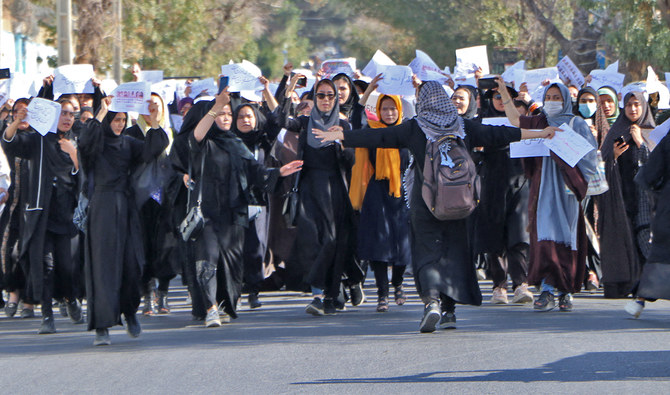KABUL: Women demonstrations in Afghanistan have been on the rise since last week’s deadly bombing at an education center in Kabul, with activists saying they are emboldened by the ongoing protests in Iran.
The blast at the Kaaj education center in the Dasht-e-Barchi area in the west of the Afghan capital targeted teenage students taking a practice college exam.
At least 43 people were killed and 83 wounded when a suicide bomber detonated himself in the exam hall where about 500 children were sitting. Most of the victims were girls from the Hazara community, which has often been targeted by militants.
Since the Sept. 30 attack, female activists have been coming to the streets across the country, mobilizing to condemn the unrelenting violence as well as restrictions on women and minorities.
Although the protests have been dissolved by Taliban authorities — which since taking control in August 2021 have curbed women’s rights — dozens of demonstrators showed up in Kabul and the provinces of Herat, Bamyan, Balkh, Nangarhar and Ghazni in the past six days.
“I am glad women from different parts of the country are joining us in condemning the attack on Hazara female students in Kabul. I would request other sisters and brothers to do the same,” Razia Mohseni, a 34-year-old women’s rights activist from Kabul, told Arab News.
“The recent protests in Iran are inspiring to us as well. Women in Iran and here are suffering from almost the same problems. Women across the country and beyond should join hands to make their voices heard. Together we all win.”
In neighboring Iran, countrywide demonstrations, which began in mid-September, have been the largest manifestation of dissent in over a decade.
Triggered by the death of a 22-year-old woman, Mahsa Amini, in the custody of Iranian morality police, the protests have spread to all of Iran’s 31 provinces, with ethnic and religious minorities joining in, despite a violent response from authorities.
For Afghan women, the protests in Iran are a “symbol of resistance and awakening,” Zarmina Sharifi, a 26-year-old activist from Nangarhar, said.
“Our sisters were killed in an attack on Kaaj educational center in Kabul while getting an education. While we condemn the cowardly attack, we stand with our sisters in solidarity. We ask the authorities to protect students and educational centers.”
While security forces disperse them, as since September last year permission from the Ministry of Justice has been required to organize protests in Afghanistan, women say they have to raise their voices.
“We can’t remain silent about the killing of our sisters. We want protection and our rights. We are not doing anything wrong by raising our voices for the oppressed,” Hafiza Jami, a student of the University of Herat, told Arab News.
“Women in Iran and Afghanistan should be able to live their lives free of fear. That is what our protest is all about. At times like this, being together gives us strength.”














